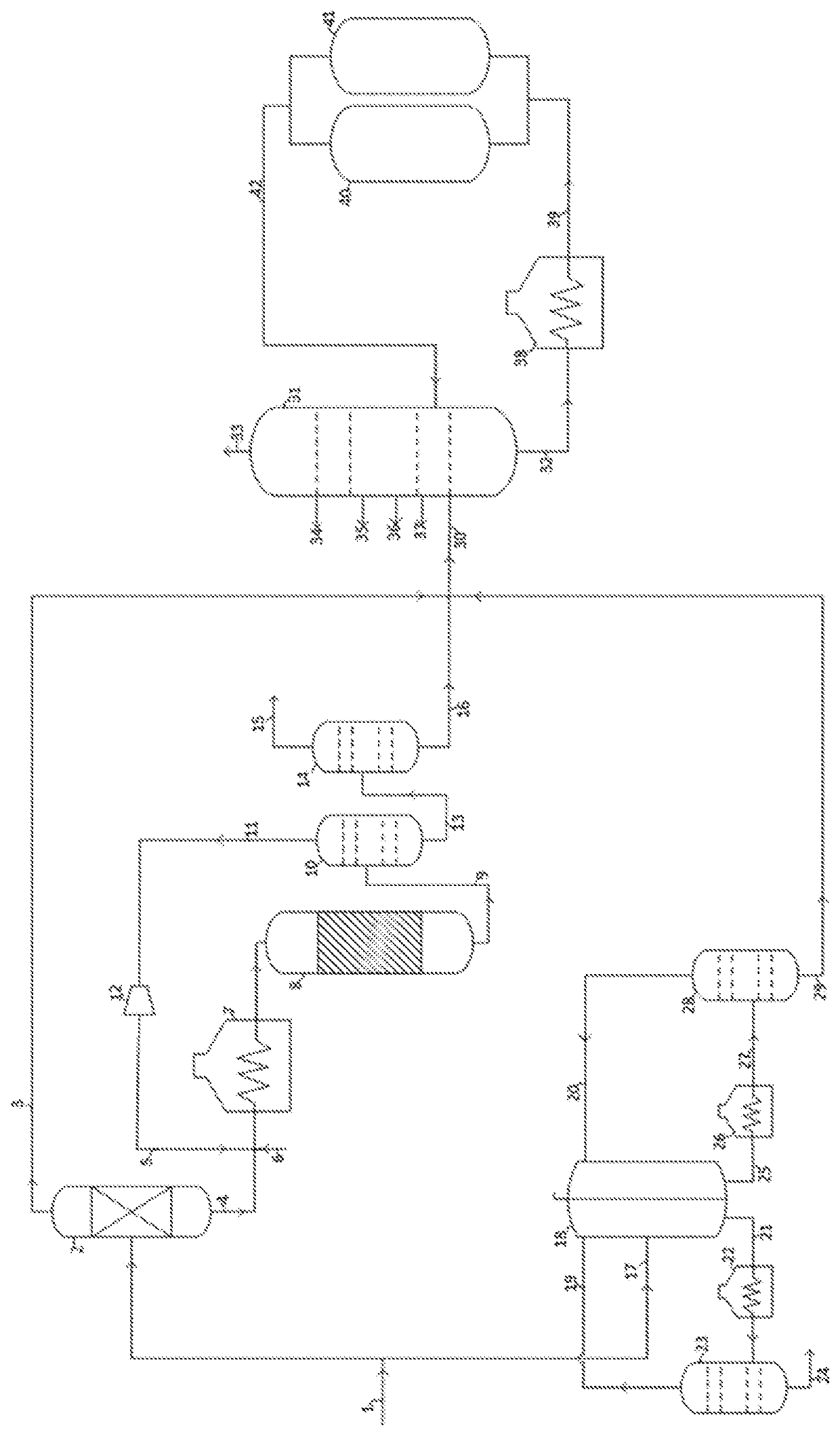Process for production of anisotropic coke
- Summary
- Abstract
- Description
- Claims
- Application Information
AI Technical Summary
Benefits of technology
Problems solved by technology
Method used
Image
Examples
example 1
[0128]Clarified oil with properties provided in Table 1, was taken for batch mode extraction as per procedure explained below.
TABLE 1Sulfur, wt %1Aromatics, wt %70.5Saturates, wt %29.5H2, wt %11Aromaticity, wt %38
[0129]100 kg CLO with properties as given in Table 1 was split into two fractions in 9:1 ratio. The 10 kg CLO was subjected to aromatic extraction using NMP as solvent at 45° C. temperature in bench scale batch extractor unit. The remaining 90 kg of CLO was subjected to distillation to remove lighters of ˜6 wt % and the heavier portion was subjected to hydrotreatment at 340° C. temperature and 42 Bar pressure. The final feed blend was prepared by mixing the Desulfurized CLO and Aromatic extract samples and the properties are provided in Table 2.
TABLE 2Sulfur, wt %0.26Aromatics, wt %66.41Saturates, wt %33.59H2, wt %11.66
[0130]One experiment was carried out by using the clarified oil feedstock blend as provided in Table 2 in Batch-Coker unit and the coke generated was calcine...
example 2
[0131]Clarified oil with properties provided in Table 4, was taken for batch mode extraction as per procedure explained below.
TABLE 4Sulfur, wt %1.88Aromatics, wt %76.6Saturates, wt %23.4H2, wt %10.5
[0132]100 kg CLO with properties as given in Table 4 was split into two fractions in 9:1 ratio. The 10 kg CLO was subjected to aromatic extraction using NMP as solvent at 45° C. temperature in bench scale batch extractor unit. The aromatic extract was separated. The remaining 90 kg of CLO was subjected to distillation to remove lighters of ˜6 wt % and the heavier portion was subjected to hydrotreatment at 340° C. temperature and 42 Bar pressure. The final feed blend was prepared by mixing the Desulfurized CLO and Aromatic extract samples and the properties are provided in Table 5.
TABLE 5Sulfur, wt %0.37Aromatics, wt %63.41Saturates, wt %30.59H2, wt %11.25
[0133]One experiment was carried out by using the clarified oil feedstock blend as provided in Table 5 in Batch-Coker unit and the coke...
example 3
[0134]Clarified oil with properties provided in Table 7, was taken for batch mode extraction as per procedure explained below.
TABLE 7PropertyValueSulfur, wt %1.88Aromatics, wt %76.6Saturates, wt %23.4H2, wt %10.5
[0135]100 kg CLO with properties as given in Table 7 was split into two fractions in 9:1 ratio. The 10 kg CLO was subjected to aromatic extraction using NMP as solvent at 45° C. temperature in bench scale batch extractor unit. The aromatic extract was separated.
[0136]The remaining 90 kg of CLO was subjected to distillation to remove lighters of ˜6 wt % and the heavier portion was subjected to hydrotreatment at 340° C. temperature and 42 Bar pressure.
[0137]The final feed blend was prepared by mixing the Desulfurized CLO and Aromatic extract samples and the properties are provided in Table 8.
TABLE 8PropertyValueSulfur, wt %0.57Aromatics, wt %72.45Saturates, wt %27.55H2, wt %11.09
[0138]One experiment was carried out by using the clarified oil feedstock blend as provided in Tabl...
PUM
 Login to View More
Login to View More Abstract
Description
Claims
Application Information
 Login to View More
Login to View More - R&D
- Intellectual Property
- Life Sciences
- Materials
- Tech Scout
- Unparalleled Data Quality
- Higher Quality Content
- 60% Fewer Hallucinations
Browse by: Latest US Patents, China's latest patents, Technical Efficacy Thesaurus, Application Domain, Technology Topic, Popular Technical Reports.
© 2025 PatSnap. All rights reserved.Legal|Privacy policy|Modern Slavery Act Transparency Statement|Sitemap|About US| Contact US: help@patsnap.com

